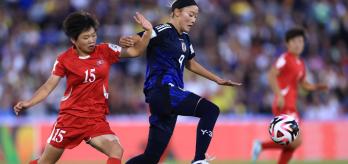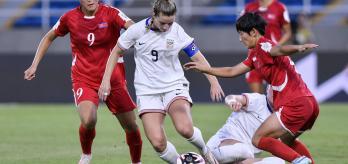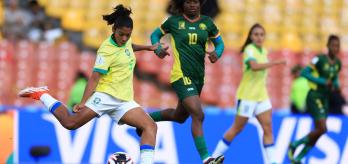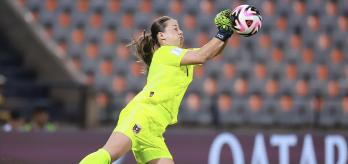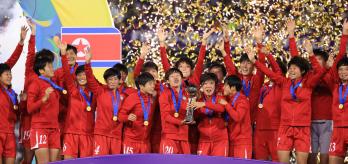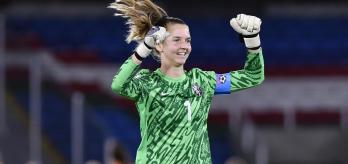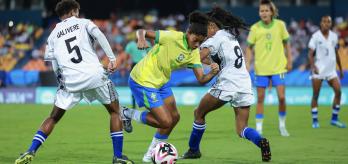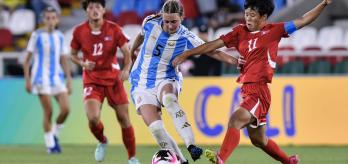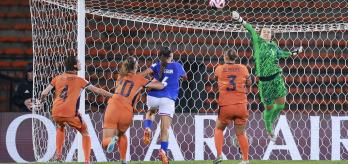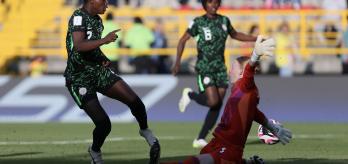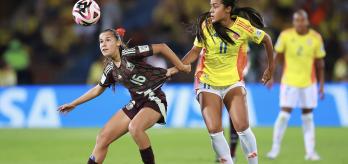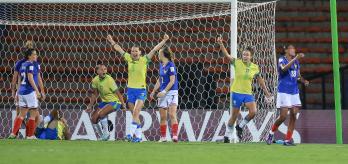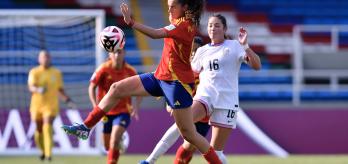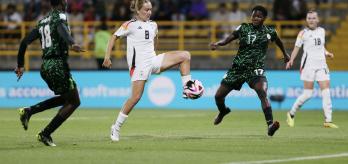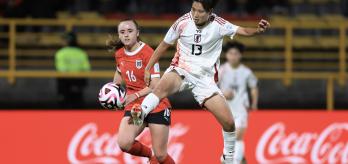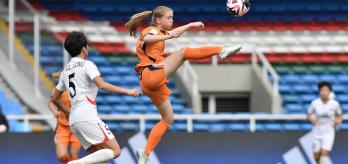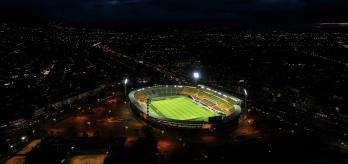In addition, the synchronised way the team played together demonstrated a deep understanding of their roles with all players showing huge commitment to fulfil their responsibilities from the first whistle to the last.
Carolina Pineda is based in Cali for the FIFA U-20 Women’s World Cup Colombia 2024™ and attended Korea DPR’s opening matches against Argentina and Costa Rica. In this article, she explains some of the key components of their attacking style that made them stand out during the group stages.
“Individually, every player has exceptional technique with mastery in all skills. They can pass the ball with devastating accuracy, can go 1v1 and beat opposition players and they can strike at goal with different parts of their feet from varied distances and ranges. They are quite unique in that all players seem to be able to play at the same level. Every player seems to be involved in every attacking sequence, using the full pitch territory extremely well, whether that’s occupying defenders, or occupying space. Whether they receive the ball or not, all players are playing an active role, and this continues even after substitutions are made. Nothing seems to stop their momentum. It was amazing to watch,” she explained.
Attacking characteristics
Korea DPR dominated possession in their opening matches, registering 63% versus Argentina and 59% against Costa Rica. Crucially, after the first two rounds of games, they are ranked number one in the tournament for receptions in the opponent’s penalty area with a staggering 37 per 30 minutes in possession. To put this figure in context, it also ranks higher than any team at the last FIFA U-20 Women’s World Cup in Costa Rica two years ago, where Brazil were ranked highest with 26.5 (Brazil with 30 and Canada with 28 have also beaten 2022's highest figure). They are also ranked number one for offers to receive in the final third with an incredible 165 per 30 minutes in possession.
In the clip below, we see an example of how efficient they are at playing forward and getting numbers up the pitch. If their attacks break down, they have players in close proximity to initiate a counter-press and when they win the ball back, that determination to play forward quickly, with minimal touches, kicks in again – there is a relentlessness and purpose to their attacking intent.
Changes in tempo
One of the key characteristics of Korea DPR’s attacking play is their ability to change the tempo of their attacks both individually and collectively. They build play through their centre-backs and midfielders in a controlled and methodical way, teasing out gaps in their opposition’s shape. Once the spaces emerge, they attack and penetrate swiftly using minimal touches to progress the ball.
As Pineda explains, “We were amazed at how they go from slow to fast, individually when carrying the ball or using passes that cut straight through their opposition’s team shape. Other players are constantly moving and filling spaces in perfect sync with the player on the ball, so they always have a variety of options when it comes to distributing the ball. They are very effective at playing through the middle before going wide and changing the speed of the game. While this is happening, players ahead of the ball are moving while wide players vary their positioning to receive.”
Below, Pineda has selected two examples of how Korea DPR changed the tempo of their build-up play through central combinations and going 1v1.
Playing through with combinations
In central areas, the front four players played close together and were constantly offering to receive from their midfielders or defenders. In clip 2 below, we see a strong example of the type of central combination play that Korea DPR could execute. Their technical ability to play the ball one-touch generates speed in their play, but the supporting runs and movements from players ahead of, and around the ball, increases their playing tempo significantly, making it very difficult to stop.
Going 1v1
All Korea DPR players have mastered ball-carrying technique and have displayed their willingness to change the tempo of the game by driving forward with the ball and taking opposition defenders on. Their ability to change direction with explosive accelerations made it extremely difficult for opposition players to contain them.
Clip 3 below shows a great example of how they progress the ball centrally, before playing wide to Jon Ryong Jong (13) who goes 1v1 as she enters the penalty area. Her sharp change of direction takes her down the outside of the nearest defender with the explosive acceleration gaining her a yard of space. As she approaches the byline, she crosses towards the back post area, providing the assist for the goal scored. It is also notable that Korea DPR have four players in the penalty area awaiting the delivery of the cross.
Loading the penalty area
Another standout feature of Korea DPR’s final-third play is their ability to get a minimum of four players into the penalty area to attack crosses. After the first two rounds of games, Ri Song Ho’s side were ranked first in the tournament for the completion of crosses from open play, with 8.5 deliveries per 30 minutes in possession. And while they demonstrated an ability to vary their crosses, they were also ranked second for cut-back crosses from open play with 2.5 (P30IP).
As Pineda explains, they play with real game intelligence and awareness of where to be in relation to the ball.
“The willingness of opposite side players and midfielders to get into the penalty area is impressive because sometimes they must work hard to get there. Even during attacking play which does not end with a cross, they still look to get players in the central areas, so they are alive to react to rebounds and second balls within the penalty area. They like to be close to the goal when they make attempts to score.
“When their players arrive in the penalty area, they often make it difficult for the opposition defenders to mark them because of their constant movements. Their forward players take up positions on the blindside of defenders and work to position themselves between defenders making it almost impossible to defend,” she added.
In clip 4 below, we can see how the four players inside the penalty area adapt positions that provide a variety of crossing options. The goal is framed with options at both the first and second post, while there are two additional players providing alternative options outside the goal area (six-yard box).
In clip 5, we see a transition to attack with a long pass from midfielder Kim Song Gyong (9), releasing Choe Il Son (15) into the final third. She is isolated when she receives the ball but four of her team-mates work extremely hard and sprint to the penalty area to support the attack, which results in a goal being scored.
Summary
In the early stages of FIFA U-20 Women’s World Cup Colombia 2024, Korea DPR have shown a relentless appetite to attack opponent’s penalty areas. They do this by progressing their play at speed, using explosive combinations and take-ons to change the tempo of their play. All players have the technical ability to play one-touch forward passes which are facilitated by consistent movements and offers to receive by players ahead of, and around the ball.
There is strong cohesion in their team’s play with excellent positional awareness and a willingness to work hard to get numbers around the player in possession. Once in the final third, they load the penalty area to offer a variety of crossing options for the player on the ball, demonstrating their ability to execute one-touch finishes from first and second balls.






